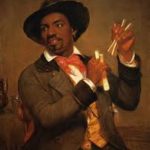Origin
In itself, bones have been found through different areas of the world: India, China, Roman Empire, Ancient Greece, and– mostly notably– Egypt, where they were known as clappers. Such as today, the instrument would be used in folk music. Bones are known for being the oldest musical instrument; accompanied by the fact that all human life potentially stemmed from Africa, its Black origins are amplified.
The bones leaked its way into American culture after the arrival of Irish immigrants, and would spike in popularity during the mid 1800s when they were used by whites in minstrel shows, appropriating African culture and music. Despite their immense, though undeserved, popularity at the time, as minstrels died out, so would the bones.
Bones were made with animal bones in the ancient past, typically taken from the ribs. They are now most commonly made from wood and other hard material of the like. They are played by clicking the wooden bars together, typically two on each hand. Bluegrass and folk often featured the bones.
http://https://www.youtube.com/watch?v=6lYFzWSnOLs
Bones and The Banjo
It’s not uncommon to see the bones and the banjo being played in unison, as they coincide nicely together. Banjo also has a history of being appropriated; with bones fading into obscurity, the banjo would be popularized and associated with the southern white archetype rather than its enslaved Black craftsmanship origins.
In 1856, painter William Sidney was commissioned to create two pieces, each which would be simply named “The Banjo Player” and “The Bone Player,” each featuring a Black man playing the banjo and bones respectfully. Sidney also happened to be a musician, which further inspired these creations. The African-American identity was seen as exotic to Europeans, making these paintings sell relatively well. What stuck out about these paintings was how carefully created the two men were drawn, simply capturing their features rather than depicting them in racist manners. There still remains controversy around him drawing the men with stereotypical instruments when the civil war would be right around the corner, but overall, he respected the individuals’ appearance artistically.



